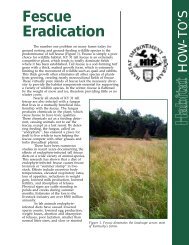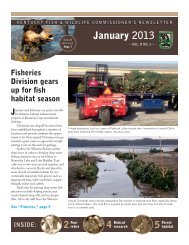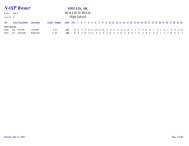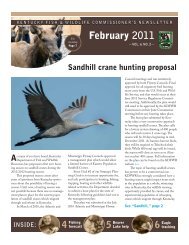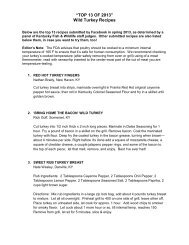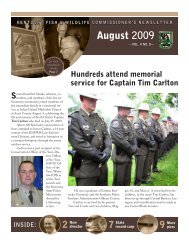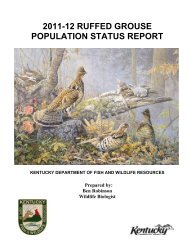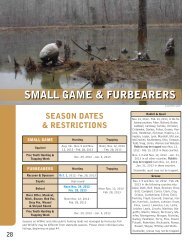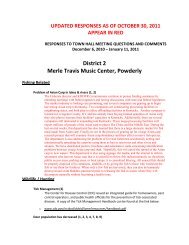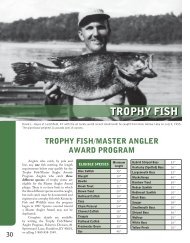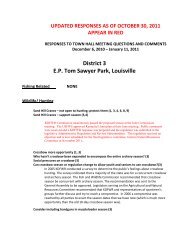2011 Region 1 Kentucky NASP Championship
2011 Region 1 Kentucky NASP Championship
2011 Region 1 Kentucky NASP Championship
Create successful ePaper yourself
Turn your PDF publications into a flip-book with our unique Google optimized e-Paper software.
<strong>2011</strong> <strong>Region</strong> 1 <strong>Kentucky</strong> <strong>NASP</strong> <strong>Championship</strong><br />
WHERE<br />
Trigg County High School 203 Main Street, Cadiz, KY 42211<br />
WHEN<br />
The tournament will be conducted on March 4th & 5th, <strong>2011</strong>.<br />
Participating schools will be able to select their first and second choice from the flights below; based on availability we will<br />
do our best to honor the choices.<br />
Friday Elementary Tournament: Flight #1 – 6:00 pm Flight #2 – 7:00 pm Flight #3 – 8:00 pm<br />
Awards – 9:00 pm<br />
Saturday Middle & High School Tournament: Flight#1 – 9:00 am Flight#2 – 10:00 am<br />
Flight #3 – 11:00 am Flight#4 – 12:00 pm Flight#5 – 1:00 pm<br />
Flight#6 – 2:00 pm Flight#7 – 3:00 pm Awards – 4:00 pm<br />
Shooters must be at their lane assignment 15 minutes before their assigned shooting time. To meet this line-up time requirement,<br />
schools should arrive at the tournament registration desk at least one hour before their shooting time.<br />
Admission for the public: $3 adults, $2 students (Under 5 free)<br />
Two coaches per team will be admitted free.<br />
Shooters and alternates will also be admitted free.<br />
REGISTRATION:<br />
Registration will be handled by regional coordinator, Christy Dickerson christy.dickerson@trigg.kyschools.us.<br />
All registration information for the regional tournament will be emailed as soon as it is available. All registration must be<br />
completed by Wednesday, February 3 rd .<br />
The registration fee is $10 per shooter.<br />
Each registered archer and up to 2 coaches from each registered team will receive a souvenir t-shirt.<br />
Tournament Rules:<br />
I. Participation<br />
A. <strong>NASP</strong>® Schools: Every competitor must attend a school offering <strong>NASP</strong>® lessons as part of the curriculum.<br />
B. 4-12th Grade Students: Only students who are in grades 4-12 by the date of the tournament may participate.<br />
C. A student below 4 th grade may participate if documentation from the school principal is provided to <strong>NASP</strong>® at the on-site<br />
registration desk indicating the student has participated in the school’s <strong>NASP</strong>® classes and can safely perform all tournament<br />
procedures with <strong>NASP</strong>®-specific equipment.<br />
D. Competitive Divisions: Elementary: 4th-6th grades, Middle: 7th & 8th grades, High: 9th-12th grades.<br />
E. A student at a <strong>NASP</strong>® school that has graduated during (i.e. early) the current school year may, at the discretion of the coach,<br />
be registered to participate.<br />
F. Team Size: <strong>NASP</strong>® archery teams must contain 16-24 students, at least 5 of which must be of the opposite gender.
G. Shooting “Up”: A student, who by grade would be in a younger division (elementary or middle school), may shoot “up” for a<br />
team in an older division, if the student is from the same school or same district and both schools offer <strong>NASP</strong>® as part of the<br />
school’s curriculum.<br />
H. Unless shooting ‘up’, students may only shoot for a team at the <strong>NASP</strong>® school they attend.<br />
I. A school may register one or more teams.<br />
J. Single Gender or Small Schools: If the school is single gender, opposite gender participants may come from other <strong>NASP</strong>®<br />
schools in the same city, county, or school district. If the school contains fewer than 125 students (combination of grades<br />
4-12) the team may be comprised of students from other participating small (< 125 students) <strong>NASP</strong>® schools in the<br />
same city, county, or district.<br />
Interpretation of Elementary Students in 4 th , 5 th , and 6 th Grades:<br />
What do G. and H. above mean to 4-5 th grade students who attend an elementary school without 6 th graders and to 6 th graders who<br />
attend a middle school without 4-5 th graders?<br />
The 4-5 th graders may not shoot on an elementary team with the 6 th graders because they don’t attend the same school – violates rule<br />
H. The 6 th graders may not shoot on an elementary team with the 4-5 th graders because they don’t attend the same school – violates<br />
rule H. Being an elementary feeder school to a middle school does not qualify for an exception to these rules.<br />
A “school” for the purposes of participation in <strong>NASP</strong>® tournaments is a building or set of buildings on the campus where students at<br />
that school attend. For instance, a high school may have 9 th grade and 10 th -12 th grade students on the same campus but in different<br />
buildings. For the purposes of <strong>NASP</strong>® participation, this is one school. In another school all students K-12, 6-12, etc. may be in the<br />
same building or buildings on the same campus. This is one school. If a school or campus is at a separate address such as the “North<br />
Middle School and North Elementary School” even if in the same district, they are separate schools and separate campuses and may<br />
not mingle shooters on teams unless shooting up as per “G” above.<br />
II. Equipment -- Only equipment specified for use in the <strong>NASP</strong>® may be used in the tournament.<br />
A. Bows: Only the stock (original), unmodified Genesis bow approved for <strong>NASP</strong>® may be used.<br />
a. Only thread knots or heat shrink nock locators will be permitted to be used. The bow string may have 1 or 2 nock<br />
locators. If two nock locators are used the arrow nock must be placed between them. Brass nock locators are<br />
prohibited. Instructions for tying on a nock locator are available at www.nasparchery.com<br />
b. The bow must be sight and sight-mark free. Camouflage bows may be used, but the face of the riser window must be<br />
covered to prevent camouflage lines serving as sight-marks. Tape or paint placed to cover sight marks must remain<br />
in place throughout the competition. The flight cannot be delayed to cover sight marks. It is important archers and<br />
coaches check every bow for compliance before their flight time.<br />
c. The bow must be free of draw stops or stabilizers.<br />
d. The bowstring and cables may be “after-market” but of the same approximate length.<br />
e. The cable guard, slide, wheel, cam, bearings, riser, and limbs must be original and unmodified.<br />
f. An archer’s bow may be personalized by painting, stickers, etc. as long as sighting aids are not created.<br />
g. The arrow rest must be original and unmodified. A missing rest arm sleeve is permissible.<br />
h. All bows must be on bow racks for range official inspection before shooting begins.<br />
i. Bows may not be taken behind the waiting line without range official approval once shooting begins.<br />
j. The bow’s draw weight must remain unchanged after the 1 st non-practice arrow is shot at 10 meters.<br />
k. Loaner Bows: Archers are encouraged to bring their own <strong>NASP</strong>® bows. A very small number of “loaner” bows will<br />
be available in case of equipment failures. Our single line format is unsuitable for bow-sharing.<br />
B. Arrows: Only arrows and arrow components approved for use in the <strong>NASP</strong>® National Tournament may be used.<br />
a. Arrow Supplies: Only Easton Arrows marked with the Genesis TM or <strong>NASP</strong> logo may be used. The arrows provided<br />
will be the <strong>NASP</strong>® standard with full-length 1820-size Easton aluminum shafts and glued nocks. Personal arrows<br />
may be used at the <strong>2011</strong> KY <strong>Region</strong>al <strong>NASP</strong>® Tournament but they must be marked to permit easy identification and<br />
meet the <strong>NASP</strong>® specifications. The new <strong>NASP</strong>® approved arrows with the push in nocks may be used.<br />
C. Accessories: Archers may wear finger tabs, tape, or gloves to protect draw-hand fingers. “No-glove” finger-protection devices<br />
may be placed on the bowstring. Heat shrink tubing may be placed on the bowstring to reduce finger strain but the tubing must<br />
cover the entire center serving above and below the nock locator(s). Archers may wear arm guards. Finger or wrist slings are<br />
allowed. Wrist slings may be attached using the stock bolt that comes with the strap. The bolt must be made of steel or plastic<br />
and must protrude one inch or less beyond the bow’s accessory hole. Mechanical release aids are not allowed. “Sims”<br />
vibration dampeners on the limbs are allowed.
D. All bows, arrows, and accessories used by participants may be subjected to inspection, including dismantling at the discretion<br />
of tournament officials. Anyone found using disallowed equipment or modifications will forfeit their awards and be disqualified<br />
from the rankings. Disqualification may affect their team’s rank.<br />
III. Competitive Format<br />
A. Range Set-Up:<br />
a. Targets will be the standard <strong>NASP</strong>® 80 cm FITA face with 10 scoring rings.<br />
b. Target butts will be placed directly on the floor similar to the height of school butts.<br />
c. Targets will be attached to the butts approximately 4 inches above the floor.<br />
d. The target line will be approximately 2 yards or meters from the target butts.<br />
e. There will be 10 and 15 meter shooting lines.<br />
f. The waiting line will be at least 4 yards or meters beyond the 15 meter shooting line.<br />
g. A “Coaches Alley” will be delineated between the waiting line and spectators.<br />
h. Spectator seating will be placed as close as possible behind the waiting line.<br />
i. Five foot wide shooting lanes will be used with 2 archers assigned per lane per flight.<br />
j. Shooters occupying a lane will be from different schools.<br />
B. Whistle Signals: <strong>NASP</strong>® whistle commands will be used to operate the range.<br />
a. 5+ whistles for an emergency<br />
b. 2 whistles to “get bow”<br />
c. 1 whistle to “shoot”,<br />
d. 3 whistles to “go get arrows”<br />
C. Arrow Handling and Moving About the Range: <strong>NASP</strong>® safety rules must be followed.<br />
a. Archers must walk when moving about the range.<br />
b. Archers must have one foot on each side of the shooting line with “bows on toes” before shooting begins.<br />
c. The tournament-provided arrow quiver must be placed ON the shooting line in FRONT of the archer.<br />
d. Archers must remain standing when at the targets scoring and pulling arrows.<br />
e. While both archers may approach the target when scoring, only one archer may remain at the targets when arrows<br />
are pulled. The other archer must be safely behind the target line while arrows are being pulled.<br />
f. Points must be covered with one hand and shafts grasped just below the vanes with the other when carrying arrows.<br />
g. The archer must pre-draw, draw, and aim in a manner to keep the arrow pointed safely below the top of the backstop<br />
curtain at all times.<br />
D. Order of Shooting<br />
A. Each archer will shoot two practice ends of 5 arrows at 10 meters and then shoot 3 scoring ends of 5 arrows (15<br />
arrow total) at 10 meters.<br />
B. Each archer will shoot one practice ends of 5 arrows at 15 meters and then shoot 3 scoring ends of 5 arrows (15<br />
arrow total) at 15 meters.<br />
C. Archers will have 2 minutes to shoot each 5-arrow end. An alert will be provided near the conclusion of each end. For<br />
tournament management purposes, no time clock will be in view of the archers.<br />
D. An arrow that bounces off the target may be shot again as instructed by range officials.<br />
E. A dropped arrow will be left on the floor and replaced by a range official.<br />
F. An arrow that reaches the target line in the air or by sliding on the floor without hitting the target is considered a shot<br />
rather than a dropped or a bounce-out arrow and will be scored zero points.<br />
E. Dress Code<br />
A. It is <strong>NASP</strong>® desire that its tournaments continue to be an extension of the educational experience enjoyed by its<br />
participants. It is important that students remain safe and comfortable. Therefore:<br />
a. All student archers must wear close-toed shoes. (bare feet and sandals are disallowed)<br />
b. All coaches should make sure their student archers adhere to their school’s dress code at the tournament.<br />
c. Behavior considered disruptive, unsafe, or otherwise inappropriate at the event may result in expulsion.<br />
F. Scoring<br />
A. All arrows must be scored before any arrow or the target’s face is touched.<br />
B. Beginning in the center of the target, scoring rings are 10, 9, 8, 7, 6, 5, 4, 3, 2, &1.<br />
C. An arrow touching the line is awarded the higher point value.
D. An arrow that isn’t in a scoring ring is awarded “O” points.<br />
E. The “X” ring in the center of the 10 is simply scored as a 10.<br />
F. An arrow that “robin-hoods” another arrow receives the value of the arrow in the target.<br />
G. An arrow that skips off the floor and strikes the target is scored where it lands.<br />
H. An arrow that skips off the floor and bounces off the target is treated as a bounce-out.<br />
I. Summation of the highest 12 individual scores, with at least 4 of both genders will comprise the team score.<br />
J. Scannable (bubble-type) scorecards will be used. Archers should practice with this type of scorecard before coming<br />
to the tournament. Sample cards may be downloaded @ www.archeryintheschools.org<br />
K. Both archers should walk to the target in their lane.<br />
a. Both scorecards will be on the same score board.<br />
b. One archer will call the arrows he shot while the other bubbles in the score of these arrows.<br />
c. Archers will then reverse roles with the other calling the arrows she shot while the other bubbles.<br />
L. If archers cannot agree on an arrow’s score, a range official must be asked to make the final decision.<br />
M. The scorecard must be signed by the archer and lane-mate at the conclusion of shooting and scoring.<br />
N. Range officials will gather signed scorecards at the conclusion of each flight at the target.<br />
O. Disqualification may occur if an archer takes the scorecard to the coach or other unofficial person(s).<br />
P. Only the student archer and tournament officials will be allowed downrange of the waiting line.<br />
IV. Coaches Review Room: 15 minutes after each flight is over, a coach representing each team should meet in the Coaches<br />
Review Room to review scores and scorecards. The coach will be asked to sign a statement that the scores are correct.<br />
If there is a problem, our staff will work with the coach to resolve it. The official scorecards will be available to the coach at<br />
the end of the tournament.<br />
V. Awards:<br />
A. One team trophy will be awarded to each of the 1st, 2nd, and 3rd place teams in each division.<br />
B. Each 1st thru 3rd place teams’ members will also receive a medal.<br />
C. Medals will be awarded to 1st thru 5th place individual boys and girls in each division, Elementary School, Middle<br />
School, and High School.<br />
VI. Protest Procedures:<br />
A. Protests may concern scoring or equipment compliance.<br />
B. A Protest Committee will be designated to receive, consider, and resolve official protests regarding the tournament.<br />
C. Tournament officials will be in the “Coaches Review Room” within 15 minutes following the conclusion of every flight.<br />
D. Coaches are encouraged to visit the “Coaches Review Room” within 15 minutes of the conclusion of their flight to<br />
examine the team’s official scores and scorecards. If a team or archer’s representative does not attend the review<br />
immediately after the flight, those scores will be deemed final.<br />
E. Only the officially registered coach of the archery team or individual may file a protest.<br />
F. The coach may not be accompanied by the archer, a parent, or anyone other than a registered coach unless<br />
requested by the committee.<br />
G. A protest must be received by the committee within 45 minutes following the conclusion of each flight.<br />
H. Video or other photographic evidence regarding the protest will not be considered.<br />
I. Decisions made by the protest committee are considered final.<br />
VII. National <strong>NASP</strong>® reserves the right to modify, remove or add items as needed. Please go to<br />
www.archeryintheschools.org for the latest version of the Official Rules & Regulations. Check back often.



